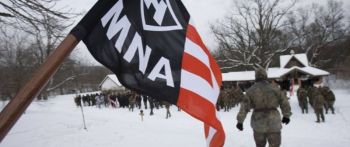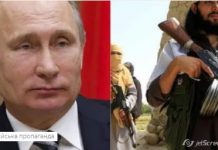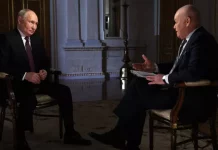The shooting of a Hungarian police officer by a neo-Nazi leader spotlights the group’s Russia ties and wider threat to the region.
OpEd, by Peter Kreko and Lorant Gyori, TOL
A tragic murder committed in a small Hungarian town this fall could end up having larger regional implications – even if the authorities in Budapest decide to hide their heads in the sand.
On 26 October 2016, a police officer was shot in the village of Bony in western Hungary, where the far-right, paramilitary Hungarian National Front 1989 (MNA 1989) has its headquarters and training camp.
The perpetrator was 76-year-old Istvan Gyorkos, leader of MNA 1989, who opened fire with a semi-automatic rifle on two officers of the National Bureau of Investigation who were raiding his house in search of illegal arms and ammunition. One officer, a 25-year-veteran, was instantly hit by the bullet spree and died on the spot. The perpetrator was also shot in the abdomen, but a quick emergency operation saved his life.
The pro-Russian ideology of the organization was well-known for a long time. But a few days later, investigative journalists from index.hu revealed that Russian officials have had ties to Gyorkos’ neo-Nazi organization for years. Russian diplomats and Russian military intelligence (GRU) members have even participated in airsoft trainings with MNA 1989.
Unfortunately, such connections do not represent an isolated case, but fit into larger international and geopolitical patterns. Gyorkos and his followers aligned themselves with the Eurasianist ideology of Alexander Dugin, an ideologist who is close to the Kremlin and has pushed for a more aggressive foreign policy in Russia’s near abroad. MNA 1989 also sympathizes with Vladimir Putin’s imperial approach in the fight against the Western and Judeo-Bolshevist world order. Interestingly, at the same time, the neo-Nazis have had friendly relations with the marginal, but also strongly pro-Russian, Hungarian Workers Party, a communist group that organized a pro-Putin demonstration when the Russian president made a visit to Hungary last year.
MNA 1989’s pro-Russian stance became blatantly obvious when its website transformed into the leading Hungarian, pro-Russian propaganda site after the Ukrainian elections in 2014. This website, Bridgehead (Hidfo), was later handed over to a professional media team comprised possibly of Russian intelligence, as evidenced by the “tank scandal,” when the site was used for disinformation purposes.
In August 2014 a minor diplomatic squabble namely broke out between Moscow and Budapest when Hidfo.net alleged that Hungary had secretly delivered tanks to Ukraine. The portal also posted a “photograph” of the tanks without identifying the source. The Russian Foreign Ministry quoted this article, criticizing EU member states for providing military help to Ukraine – a claim that Kremlin-owned media then widely publicized. The Hungarian parliament’s National Security Committee discussed the affair as well, but without any serious security policy or diplomatic consequences. Later, the website was put on a Russian server, to dissolve any doubt over its source and intent.
Hardly an Exception
The case highlights a consistent pattern of Kremlin-backed, far-right or far-left radicalization in Hungary and the wider region. The MNA 1989 is, in fact, only a small and quite isolated fraction of the pro-Russian, far-right political spectrum in Hungary that the authorities seem to be reluctant to acknowledge. The center of the subculture is the radical right Jobbik party, whose former foreign policy cabinet head Bela Kovacs has been an “observer” several times during Kremlin-backed “elections” and referenda, such as on the secession of Crimea from Ukraine. Kovacs, a member of the European Parliament, is currently under investigation for espionage on behalf of Russia and against the EU.
Jobbik partly funds and is closely associated with the revisionist Sixty-Four Counties Youth Movement (HVIM); the paramilitary, white supremacist Army of Outlaws (Betyarsereg); and another paramilitary organization, the Wolves (Farkasok). The pro-Kremlin stance of Jobbik and its satellite organizations is obvious. In 2015, the HVIM staged a demonstration at the Heroes’ Square in Budapest in support of pro-Russian separatists in eastern Ukraine to thank Alexander Zakharchenko, leader of the self-proclaimed Donetsk People’s Republic, for releasing ethnic Hungarian POWs of the Ukrainian army. The Army of Outlaws praised on its homepage the Russian military intervention in Syria along with the battle-readiness of the Russian soldiers. Zsolt Der – one of the leaders of the Wolves, a member of the Army of Outlaws, and a veteran of the Yugoslav wars – postponed his decision to fight alongside the separatists in Ukraine because he is currently serving as an assistant to the vice speaker of the Hungarian parliament, Tamas Sneider – a former skinhead, who is currently also Jobbik’s vice president.
Our organization, the Political Capital Institute, has pointed out similar far-right or far-left radicalization tendencies in other countries as well. There are several well-documented cases of Slovak far-right paramilitary figures fighting in eastern Ukraine or promoting the separatists’ case in Slovakia. One of them is Martin Keprta, a member of the Slovak Conscripts (Slovenskí Branci-SB) whose organization had earlier received training from former Russian military intelligence special forces.
Polish counter-intelligence is currently investigating Mateusz Piskorski, the leader of the Polish leftist Change (Zmiana) party, as well as former activists of the far-right Polish Congress of the New Right (KNP) on charges of pro-Russian espionage. The latter had allegedly taken part in so-called “active measures” on the territory of Ukraine in 2014 to provoke an ethnic conflict against the Polish minority living in western Ukraine.
In the Czech Republic, the “Donetsk People’s Republic” opened a “consulate” in September 2016 with the help of Czech far-right actors, including the National Militia group. The Czech Authorities did not recognize this initiative of the pro-Russian separatists as an official diplomatic entity, and the Czech Foreign Ministry vowed to close the center. The annual report of the Czech Security Information Service (BIS) also refers to widespread connections between extremist forces and Russia.
Reluctant to Act
As these incidents show, the Kremlin is highly effective in infiltrating fringe parties and paramilitary organizations in Central Europe, which are not difficult to buy up or control as truly extremist groups tend to be small and easy-to-manipulate. These pro-Russian organizations provide direct political legitimization of the Kremlin and its geopolitical goals or indirect propaganda with the same goal. Fringe groups pose not only a political threat but a national security one as well, as they tend to commit violent acts while having connections with the Russian secret services or with separatists in eastern Ukraine.
While the governments of Poland and especially the Czech Republic have taken some steps to counter pro-Russian radicalization such as arresting individuals with links to the Russian secret services, stepping up against espionage, and setting up a body to counter disinformation, there has been no concerted effort on the part of Hungary so far – clearly because of political and economic dependence on the Kremlin. There are several large, energy projects reeking of corruption, such as the Paks Nuclear Power Plant and a gas deal via the Hungarian Energy Society, which bring direct benefits for business interests very, very close to the leaders of the government.
However, signs exist of late that the Hungarian authorities will finally make a move. The tragic confrontation with the neo-Nazi MNA and Russia’s ties to the group prompted a subsequent hearing in the Hungarian parliament this month to assess the Hungarian authorities’ failure during the investigation and the Russian intelligence services’ role in the MNA’s activities. The Terrorist Prevention Agency and the police recently organized a raid against the cells of MNA 1989, confiscating a huge amount of weapons and arresting a few people.
But the responses on the governmental side seem to be one-sided and politically motivated. The ruling party, Fidesz, seems to use this opportunity as a way to crack down on its far-right opponent, Jobbik: last week, the caucus leader of Fidesz and a state secretary in the prime minister’s office hinted in parliament at the possibility of banning political parties that have connections to paramilitary organizations. And while Jobbik definitely had and still has some connections to extremist organizations (and also to Russia), it is not new at all – and contrary to the claims of the government, the party did not have any serious link to MNA 1989.
Yet however ready the government is to go against its opponent on the pretext of the tragedy in Bony, the authorities appear to be ignoring the elephant in the room: the Russian connection. The Ministry of Foreign Affairs (most likely, afraid of the deterioration of good Russian-Hungarian relations) admitted that officials did not even raise the issue through diplomatic channels. In addition, the minister of foreign affairs recently said that there have been no Russian diplomats or citizens expelled from Hungary, even after Bela Kovacs was accused of espionage. At the same time, several countries in the region – including the Czech Republic, Romania, and even Serbia – have expelled Russian citizens due to suspicions of malevolent foreign influence.
The shooting of a policeman in Hungary should be a wake-up call for Europe. To overcome the reluctance of some member states, such as Hungary, to reveal the potential dangers of Russian influence – and to acknowledge the pan-European nature of these threats – there is probably no other solution than for the European Commission to push for more integrated intelligence services in the EU. Otherwise, we can count on the continued growth of extremist organizations, with Russian support, and more tragedies like the one that took place in Bony.
By Peter Kreko and Lorant Gyori, TOL





